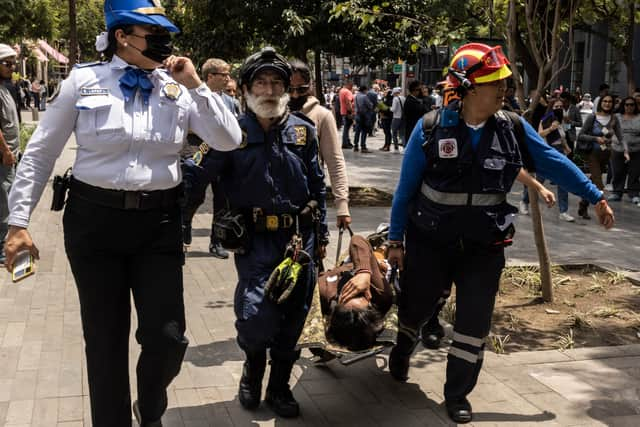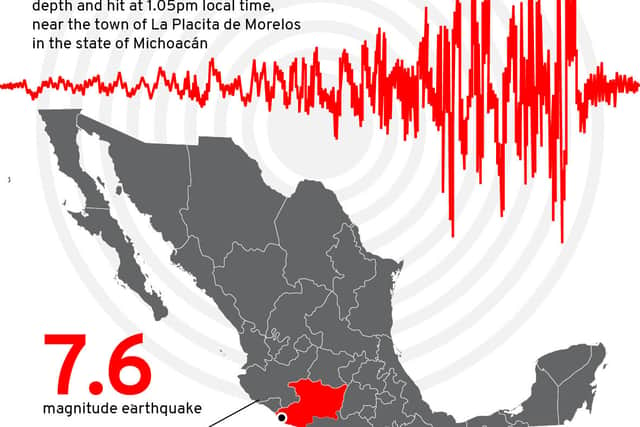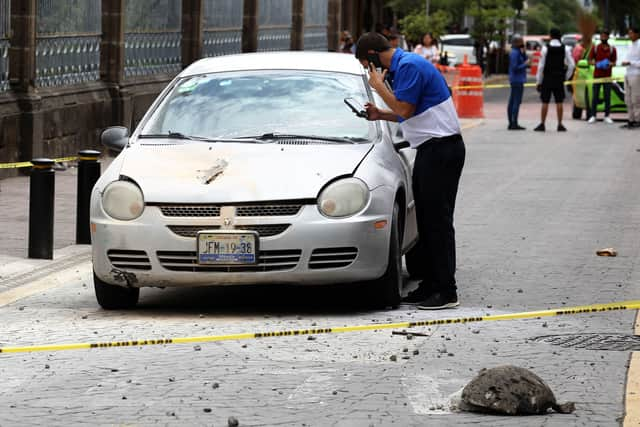Mexico earthquake: has a tsunami warning been issued - how strong was earthquake and how many were injured?
and live on Freeview channel 276
A strong earthquake hit Mexico on Monday (19 September) killing at least one person and setting off a seismic alarm.
The magnitude 7.6 earthquake has shaken the country’s central Pacific coast on the anniversary of two earlier devastating quakes, including the 1985 tragedy in Mexico City which killed more than 5,000.
Advertisement
Hide AdAdvertisement
Hide AdThe US Geologic Survey said the quake was centred 23 miles south east of Aquila, near the boundary of Colima and Michoacán states, at a depth of 9.4 miles. The US Tsunami Warning Centre said hazardous tsunami waves were possible for coasts within 186 miles of the epicentre.


What happened?
The quake hit at 1.05pm local time, striking near the town of La Placita de Morelos in the state of Michoacán at a depth of 15km.
Alarms for the tremor came less than an hour after quake alarms sounded to commemorate the deadly earthquakes that struck on the same date in 1985 and 2017.
Power was out in parts of Mexico City, including traffic lights, causing havoc with the capital’s already notorious traffic.
Advertisement
Hide AdAdvertisement
Hide AdIn nearby Colima, around 62 miles from the epicentre, “moderate” damage was reported, while in Mexico City, “light to moderate” shaking was reported. Local news channels reported that firefighters closed some buildings in Mexico City to the public due to concerns of collapse.
Mexico’s National Civil Defence agency said that based on historic data of tsunamis in Mexico, variations of as much as 32 inches were possible in coastal water levels near the epicentre.


How strong was the earthquake?
The earthquake is reported to be a 7.6 magnitude quake according to the US Geological Survey. The extent of the damage caused by the quake is still being determined.
According to the USGS, the earthquake’s centre was in the Pacific Ocean near La Placita de Morelos, about 300 miles northwest of Acapulco.
Advertisement
Hide AdAdvertisement
Hide AdA Twitter user in Puerto Vallarta - 400km north of the epicentre - captured the earthquake on video, showing the room rumbling and a ceiling fan swinging wildly.
According to the Pacific Tsunami Warning Centre, possible waves could occur within 300km of the earthquake’s epicentre. It noted that waves between one and three metres above the tide level are possible along the Mexican coast. On Monday afternoon (19 September) the agency said it had observed tsunami waves.
Waves of up to 0.3 meters above the tide level are possible for a number of nations, including Hawaii, American Samoa, Guam, Australia, Japan, Chile, Columbia, Costa Rica, El Salvador, Guatemala and Honduras.
However, the Pacific Tsunami Warning Centre said there was no tsunami threat to Hawaii following the earthquake.
Advertisement
Hide AdAdvertisement
Hide AdThe effects of the earthquake were felt hundreds of miles away. A video from Mexico City showed street signs swaying during the quake and locals crowded in the streets as a warning siren blared in the background.
How many were injured?
At least one person has been confirmed dead, according to Mexican President Andrés Manuel López Obrador. They were killed in the coastal city of Manzanilo, approximately 130km south of the epicentre.
According to the president, the person died when a wall at a shopping centre collapsed in the port city.


Has Mexico been hit with earthquakes before?
The quake occurred on the same day Mexico held its national earthquake drill, commemorating the massive quake in 1985 in Mexico City.
Another earthquake hit Mexico on the same day in Puebla in 2017, leaving 370 dead.
Monday’s quake occurred only a half an hour after the annual drill concluded.
Comment Guidelines
National World encourages reader discussion on our stories. User feedback, insights and back-and-forth exchanges add a rich layer of context to reporting. Please review our Community Guidelines before commenting.
